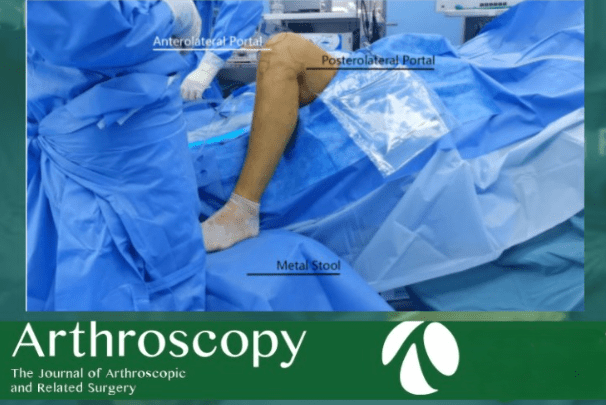Overuse, aging, or sports injuries can all cause knee pain, which can significantly impair day-to-day functioning. For many years, the only option available to those with knee problems was invasive surgery that required a long recovery period. However, patients now have access to a quicker, far less invasive solution because of arthroscopic knee surgery. This innovative technique is rapidly changing the way we treat knee pain by resulting in a quicker recovery, less discomfort, and noticeably better results.

Arthroscopic Knee Surgery: What is it?
Compared to traditional knee surgeries, arthroscopic knee surgery is a state-of-the-art, minimally invasive procedure that enables surgeons to treat knee problems with significantly smaller incisions. With this method, the surgeon can see the inside of the knee joint on a monitor thanks to an arthroscope, a tiny camera. This facilitates diagnosis as well as, if required, enables prompt intervention.
Surgeons can use specialized instruments inserted through tiny incisions to perform a range of repairs, from ligament damage to meniscal tears. One of the main benefits of arthroscopic knee surgery is that patients recover more quickly and suffer much less physical trauma thanks to this technique.
Why Is Knee Arthroscopic Surgery Required?
Arthroscopic knee surgery may be the best course of action when knee pain is persistent and conventional therapies like physical therapy or medication are no longer effective. In order to treat a specific problem that has been identified or to determine the underlying cause of your knee pain, your doctor might suggest this procedure. The following conditions are frequently treated with arthroscopy:
- Ligament Tears: Arthroscopic surgery can be used to repair any tears in the ACL or PCL, two important ligaments.
- Meniscus Tears: Twisting or abrupt impacts frequently cause damage to the cartilage that lies between the knee bones. The torn pieces can be repaired or removed with the aid of arthroscopy.
- Patella Misalignment: Pain and instability may result from the kneecap moving out of alignment. One way to realign it is through arthroscopic surgery.
- Fragments of loose cartilage: These can irritate and swell the body. They are removed by arthroscopy to enhance knee function.
- Removal of Baker’s Cyst: Using an arthroscopy, these fluid-filled sacs behind the knee can be easily removed.
What Takes Place During Arthroscopic Knee Surgery?
Depending on how complicated the surgery is, the patient is usually put under either local or general anesthesia during an arthroscopic procedure. The arthroscope will then be inserted into the knee joint by the surgeon after making a few tiny incisions, usually no more than half an inch. Once inside, the surgeon can evaluate the tissue condition and see real-time images of the knee joint on a screen.
If surgery is required, the damaged areas will be treated by the surgeon using specialized tools. These could include instruments for tissue cutting, shaving, or suturing. The entire process typically takes less than an hour, during which the surgeon diagnoses and treats the issue with speed and efficiency.
The least amount of damage to surrounding tissue is one of the most crucial features of arthroscopic surgery. This results in a quicker recovery and much less post-operative pain. Following the operation, the surgeon might apply adhesive strips or tiny stitches to seal the wounds and apply a gentle bandage to the knee.
| Aspect | Details |
|---|---|
| Procedure Duration | Typically less than an hour |
| Anesthesia | Local or general, depending on the complexity |
| Incision Size | Small incisions, usually around half an inch |
| Post-Operative Care | Minimal pain, quick return to regular activities |
| Recovery Time | Typically faster recovery compared to traditional surgery |
| Common Issues Treated | Meniscal tears, ligament tears, patella misalignment, loose cartilage, Baker’s cyst |
Arthroscopic Knee Surgery’s Advantages
The much shorter recovery period following arthroscopic knee surgery is one of its main benefits. Many patients can return to light activities in a matter of days after arthroscopy, whereas traditional knee surgery frequently necessitates weeks or even months of rehabilitation. Those who work in physically demanding jobs or are athletes may find this especially helpful.
In addition to providing a faster recovery, the procedure reduces the risks of infection and excessive bleeding that come with larger incisions. Furthermore, patients usually have less pain after surgery, which makes the whole process much easier to handle.
The accuracy of arthroscopy is another extremely useful advantage. Surgeons can diagnose and treat the issue with pinpoint accuracy using the arthroscope’s real-time imaging, making sure to only target the damaged tissue and leave the surrounding areas unaffected.
What Can You Expect During Recovery?
The average recovery from arthroscopic knee surgery is fairly quick, though recovery times can vary based on the particular procedure and patient health. Within a few hours of the procedure, the majority of patients can go back to their homes, and within a few days, they can resume their regular activities, like walking.
For extra support during the first few days following surgery, patients might be recommended to wear a knee brace or use crutches, depending on the procedure’s specifics. Additionally, physical therapy may be recommended to increase knee strength and flexibility. It is essential to adhere to your surgeon’s post-operative instructions in order to guarantee a full recovery.
Most patients find that arthroscopic knee surgery improves their function and offers long-lasting relief, enabling them to resume their regular activities without being constrained by knee pain or injury.
If you’re considering arthroscopic knee surgery, consult with your doctor to discuss your options and determine if this procedure is the best solution for your knee issues. For more information, visit trusted medical sources such as the American Academy of Orthopaedic Surgeons.
